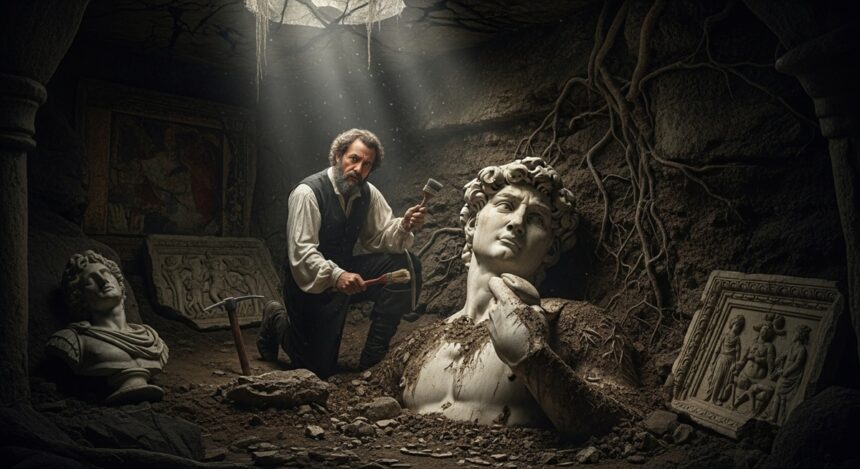We’ve all stood in awe before the timeless beauty of ancient sculptures—the graceful curves of Greek marbles, the stoic grandeur of Roman busts. They whisper stories of lost civilizations, their artistry seeming almost otherworldly, as if crafted by gods themselves. Yet, in the heart of the Renaissance, one man rose to match that unattainable perfection: Michelangelo Buonarroti.
His works, like the iconic David or the poignant Pietà, stand shoulder-to-shoulder with antiquity’s finest. But what if the secret to his genius wasn’t creation at all? What if Michelangelo wasn’t chiseling from fresh marble but excavating treasures from a forgotten era, buried deep beneath layers of earth and time?
This intriguing theory challenges everything we think we know about the Renaissance master. It suggests that Michelangelo may have “discovered” his sculptures amid the ruins of a pre-flood civilization, cleaning, restoring, and presenting them as his own. Far from a wild conspiracy, it’s rooted in historical oddities, archaeological evidence, and the artist’s own enigmatic life.
Michelangelo’s Mystique: Genius or Grave Robber?
Michelangelo Buonarroti wasn’t just an artist; he was a force of nature, a polymath who painted ceilings, designed architecture, and sculpted figures that pulse with life. Born in 1475 in Caprese, Tuscany, he grew up in a world obsessed with rediscovering the classics. By his early teens, he was apprenticed to painters and sculptors in Florence, honing skills that would redefine Western art. His big break came with the Pietà in 1499, a marble masterpiece depicting Mary cradling the dead Christ, now housed in St. Peter’s Basilica. Then came David in 1504, a 17-foot colossus symbolizing Florentine resilience.
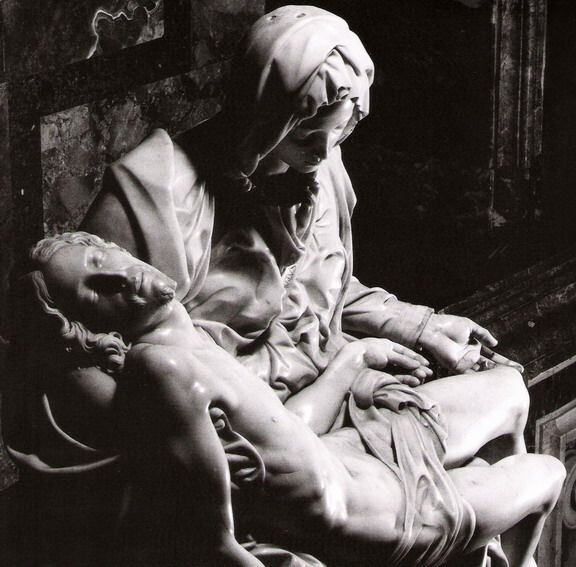
But here’s where the doubts creep in. How did a young man in his 20s achieve such hyper-realistic anatomy and emotional depth, rivaling sculptures from centuries earlier? Traditional history credits his talent and study of ancient works. Yet, whispers persist: What if those “studies” involved literal digging? After all, the Renaissance was an era of excavation frenzy, with Rome’s soil yielding treasures daily. Could Michelangelo have tapped into a hidden cache of pre-cataclysm artifacts?
A Life Shrouded in Mystery
Michelangelo lived to 88, outlasting popes and patrons, but his personal life remains elusive. He was notoriously private, destroying much of his correspondence and preparatory work. Contemporaries described him as brooding and obsessive, often working in isolation. His commissions spanned the Sistine Chapel’s ceiling—where he painted God creating Adam—to architectural marvels like St. Peter’s dome. Yet, amid this output, anomalies abound: unfinished pieces, absent signatures, and a penchant for antiquity that bordered on obsession.
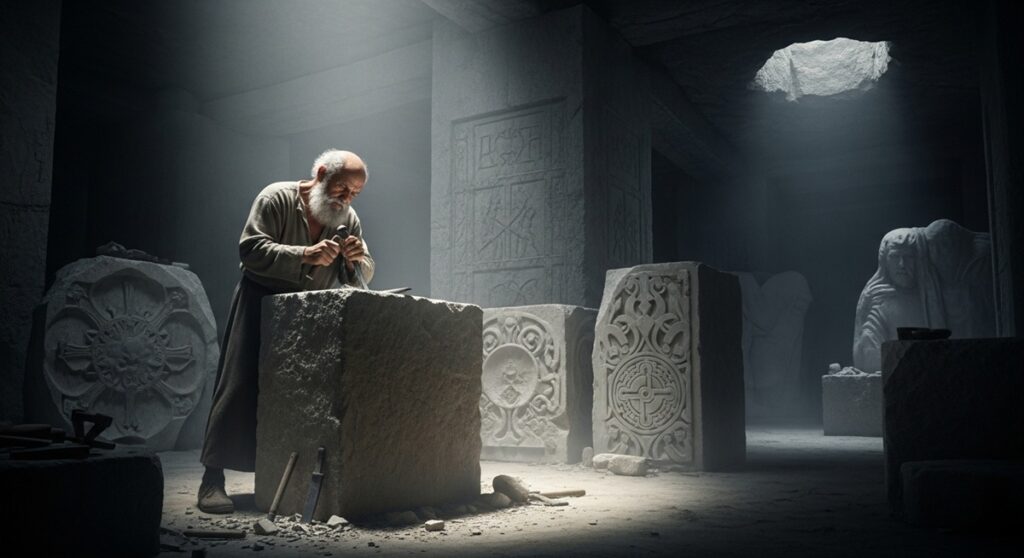
Historians note that Michelangelo dissected cadavers in secret to master human form, but no records detail how he sourced his massive marble blocks. Could some have come pre-shaped from underground? This theory gains traction when we consider the broader context of buried civilizations, potentially wiped out by a cataclysmic event.
The Great Flood: Buried Civilizations and the Mud of History
Imagine a world-ending deluge, not just biblical folklore but a global catastrophe that entombed advanced societies under feet of sediment. Flood myths aren’t unique to Noah’s Ark, they appear in Mesopotamian epics like Gilgamesh, Hindu texts, Native American legends, and even Plato’s Atlantis. Scientific theories propose massive floods around 12,000 years ago, triggered by melting ice ages or comet impacts, reshaping landscapes and burying coastal cities.
Archaeological evidence supports this. In Mesopotamia, excavations reveal flood layers dating to 2900 BCE, with clay deposits mixed with artifacts, exactly as described in ancient tales. Rome itself was a patchwork of unearthed ruins. Systematic digs began in the 19th century, but Renaissance explorers like Michelangelo stumbled upon buried forums and temples. By the 1920s, Mussolini’s projects exposed vast swaths of ancient Rome, confirming layers of mud and debris over imperial structures.
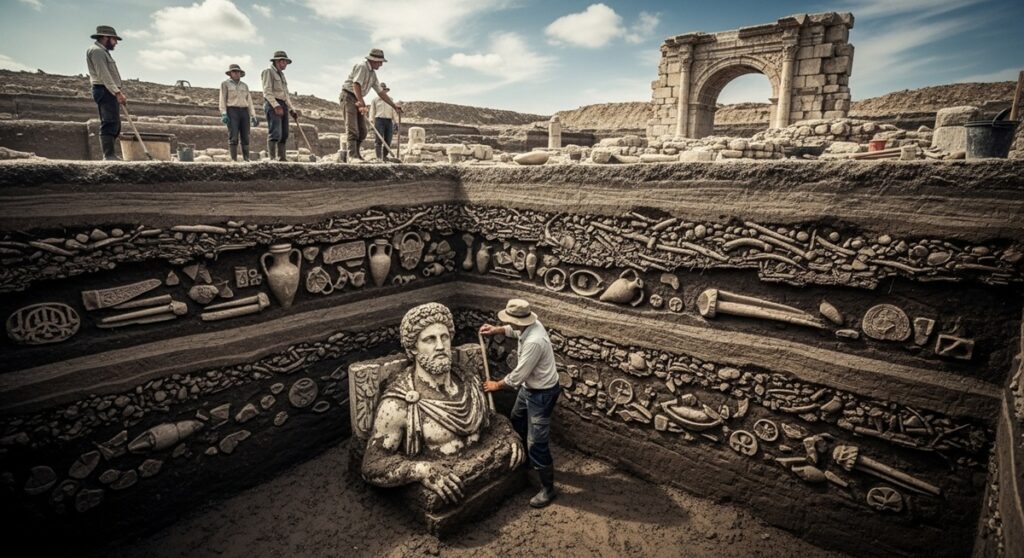
These sediments aren’t mere “cultural layers” from gradual buildup; they’re chaotic mudflows carrying pottery shards, bones, and ston, hallmarks of sudden inundation. From Turkey’s Göbekli Tepe, buried under hills, to Cambodia’s Angkor Wat, overgrown and partially submerged, ruins worldwide hint at interrupted grandeur. If a Great Flood deposited such blankets, it’s plausible that Renaissance Italy’s earth teemed with undiscovered masterpieces, ready for “rediscovery.”
Why This Matters for Michelangelo
In the 15th century, Europe was rebuilding after the Middle Ages, with antiquity’s remnants emerging everywhere. Florence and Rome were hotbeds for artifact hunters. If Michelangelo encountered buried statues—perhaps from a flooded Greco-Roman precursor—restoring them could explain his rapid ascent. After all, why reinvent perfection when it’s lying in the dirt, waiting to be polished?
Michelangelo’s Shady Side: Forgeries, Fakes, and Buried Secrets
Even Michelangelo’s contemporaries questioned his methods. Take the infamous “Sleeping Cupid” incident. In 1496, a cash-strapped young Michelangelo carved a Cupid statue, then buried it in acidic soil to age it artificially. He sold it as an ancient Greek antique to Cardinal Raffaele Riario for a hefty sum. When the fraud was uncovered—via a tip-off—the cardinal was impressed rather than outraged, inviting Michelangelo to Rome.
This wasn’t a one-off prank; it reveals Michelangelo’s familiarity with excavation and mystification. He knew how to make new look old, and perhaps vice versa. Why forge when real antiquities abounded? The theory posits he didn’t always forge; he excavated. Italy’s soil was rich with ruins, Pompeii wouldn’t be fully dug until centuries later, but surface finds were common. Michelangelo, with connections to powerful patrons, could have accessed private digs, restoring finds and claiming them as originals.
Critics argue this was youthful folly, but it plants a seed: If he buried to sell as ancient, might he have unearthed and presented as modern? His era’s obsession with classics made such switches tempting.
Echoes in His Career
Later works show similar ambiguities. Michelangelo often worked with quarried marble, but some pieces exhibit weathering inconsistent with fresh stone. And his involvement in Roman excavations? While not directly documented, the Renaissance saw artists like him advising on digs, blending roles of creator and restorer.
The Signature Scandal: Why Only One, and So Clumsy?
Michelangelo signed just one work: the Pietà. Etched across Mary’s sash: “MICHEL.A[N]GELVS BONAROTVS FLORENTIN[VS] FACIEBAT” (Michelangelo Buonarroti, Florentine, made this). But examine it closely, it’s crude, letters crammed awkwardly, the “M” undersized to fit under fabric folds.

Legend says he added it after overhearing credit given to another sculptor, sneaking in at night to chisel it. But why so sloppy for a perfectionist? Theorists argue: If the statue was unearthed, the signature was a hasty addition to claim ownership, not part of the original design. A true creator would integrate it seamlessly. And why no other signatures? Perhaps because most “his” works weren’t his to sign—they were angelic relics from a buried past.
A Hidden “M” Mystery
Restorations in the 1970s revealed an “M” on Mary’s palm, possibly a second signature or symbol. Coincidence? Or a mark from the original ancient artisan?
Michelangelo’s Name: A Divine Clue Hidden in Plain Sight?
Names carry power, and Michelangelo’s is no exception. Born Michelangelo di Lodovico Buonarroti Simoni, it’s derived from “Michael” (Hebrew: “Who is like God?”) and “Angelo” (Italian/Greek: “messenger” or “angel”). Together: “Archangel Michael.”
In Renaissance lore, unearthly beauty was attributed to divine intervention. Finding flawless statues in the earth? Surely the work of angels! Theorists speculate his name encodes this: “Michael Angel” as creator, “Buonarroti” as restorer. It’s poetic—perhaps too much so—but in an era blending myth and reality, it fits. People might have believed these sculptures were heavenly gifts, dug up by a man whose name evoked the divine warrior archangel.
Cultural Context
Buonarroti ties to Florence, but “Michelangelo” evokes celestial origins. Coincidence, or a subtle nod to the statues’ “angelic” provenance?
Vanished Preparations: Where Are the Sketches and Models?
Great artists leave trails—sketches, clay models, drafts. Michelangelo? Almost nothing. He claimed to burn his drawings twice in life, destroying evidence of his process. For David, small wax models supposedly existed, but none survive. The Sistine Chapel? Preparatory cartoons are rare and fragmented.
Convenient, say skeptics. If he was restoring unearthed pieces, no need for blueprints—just cleanup. Burning “drafts” could hide the lack thereof. Surviving drawings (about 600) are mostly studies, not direct blueprints for sculptures. This scarcity fuels doubt: Was he erasing traces of his true method?
Comparisons to Peers
Unlike Leonardo da Vinci, whose notebooks overflow with ideas, Michelangelo’s output suggests a different workflow—perhaps one starting with found objects.
Unfinished Wonders: Michelangelo’s Slaves and Ancient Echoes
Michelangelo’s “Prisoners” or “Slaves” series—six marble figures for Pope Julius II’s tomb—remain hauntingly incomplete. The Awakening Slave strains against rough stone, the Bearded Slave half-emerges, others barely roughed out. Traditionally, this non-finito style symbolizes the soul’s struggle from matter. But what if it’s literal? Dug up unfinished, left as-is when restoration proved too daunting.
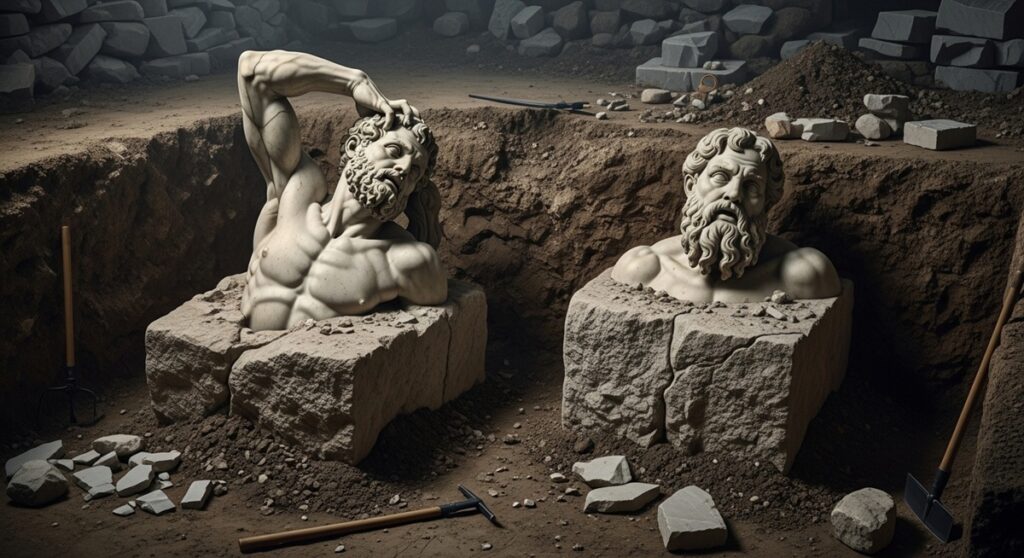
Global ruins mirror this: Siena Cathedral’s incomplete facade, Edinburgh’s half-built National Monument, Cambodia’s Ta Prohm with unpolished carvings—all halted mid-creation. Ancient sites like Puma Punku in Bolivia show precision cuts abandoned abruptly, as if a flood interrupted work.
Michelangelo’s contemporaries poetically noted he “discovered” forms in stone, not created them. Quotes abound: “Every block of stone has a statue inside it and it is the task of the sculptor to discover it.” Metaphor? Or veiled truth about excavation?
Worldwide Unfinished Ruins
From Egypt’s unfinished obelisks at Aswan—cracked mid-quarry—to Greece’s Temple of Apollo at Delphi, halted by earthquakes, interruptions are common. Turkey’s Sagalassos reveals columns left rough, much like Michelangelo’s Slaves. If a global flood struck, it explains these half-done marvels, and why Michelangelo’s “unfinished” works feel eerily similar.
Planting the Seed of Doubt: Creator or Curator?
We’ve traversed floods, forgeries, and forgotten ruins. Is there enough to question Michelangelo’s authorship? The evidence—missing drafts, clumsy signatures, unfinished echoes—builds a compelling case. Perhaps he was both genius and opportunist, blending restoration with innovation in a world ripe for discovery.
This theory doesn’t diminish his legacy; it adds layers of intrigue. What do you think? Did Michelangelo sculpt history, or unearth it? As we continue digging, who knows what else might surface.







